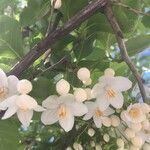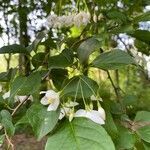Shrubs or small trees, to 8(-10) m, not suckering from roots. Leaves: petiole (2-)4-7(-10) mm; blade with 5-8 secondary veins, oblong-elliptic, ovate-elliptic, ovate to ovate-lanceolate, or subrhombic, 3-11 × 2-5(-7) cm, margins of at least some leaves apically remotely serrate, longest arms of abaxial hairs to 0.6 mm. False-terminal inflorescences 2-5-flowered, 1-4 cm; axillary flowers present on at least some shoots (subtending leaves often reduced). Pedicels 15-50 mm, longer than calyx. Flowers: calyx 4-7 × 3-5 mm; corolla (8-)10-16(-23) mm, tube 3-5 mm, lobes 5(-6), imbricate in bud, slightly reflexed, ovate, oblong-ovate, obovate, or ovate-lanceolate, 11-20 × (3-)5-7(-9) mm; filaments distinct beyond adnation to corolla. Capsules ovoid or ellipsoid, 8-15 × 8-10 mm (broader when 2-3-seeded), gray or grayish yellow stellate-pubescent, dehiscent from distal or proximal end, broadly exposing seed(s); fruit wall 0.4-1 mm thick. 2n = ca. 40.
A loose open shrub or small tree. It grows 9 m tall and spreads 2.7 m wide. The mature bark is dull grey often with orange cracks. It loses its leaves during winter. The leaves are alternate. The leaves are pear shaped and taper at both ends. They are 10 cm long by 5 cm wide. There are a few small teeth along the edge. They are dark green but silvery white underneath. The leaves turn red or yellow in autumn. The flowers are long and bell-shaped. They are 1.5 cm long. They droop in clusters under the fan like branches. The flowers are white. The fruit is round or egg shaped and grey and like a berry. It is 1.5 cm long and has one seed.



